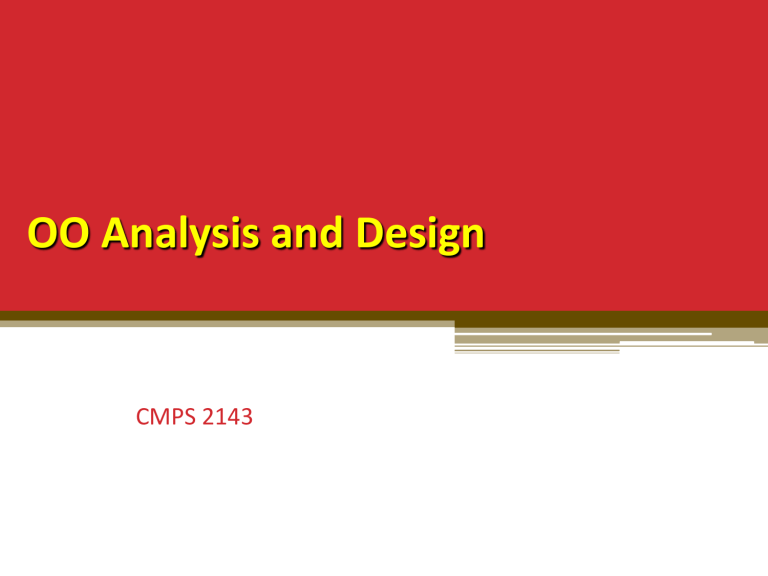OOD
advertisement

OO Analysis and Design CMPS 2143 2 OOA/OOD • Cursory explanation of OOP emphasizes ▫ Syntax classes, inheritance, message passing, virtual, static • Most important aspect: ▫ Design technique to create a universe of autonomous interacting agents ▫ We will focus on the OOD technique called responsibilitydriven design 3 Responsibility • Implies degree of independence and noninterference • Client code doesn’t need to worry about representation/implementation • Responsibility design elevates information hiding from a technique to an art. ▫ Vitally important for “programming in the large” 4 Begin with Behavior • Why? ▫ Usually it is understand long before any other aspect • Do this before data structures / order of function calls • Structural elements usually only understood after considerable amount of analysis • Customers understand system behavior 5 OOA: Describing a system • Initial system specifications are sketchy, ambiguous • Often describe actions to be performed behavior ▫ Perfect for responsibility driven design • How? With scenarios ▫ Act out the running of the application – example in book • Use these to rewrite the specifications • THEN identify components ▫ Component == abstract entity that can perform tasks to fulfill responsibilities 6 Characteristics of a Component • Must have a small, well-defined set of responsibilities • Interacts with other components to the minimal extent possible Component-ResponsibilityCollaborator (CRC) Modeling • OOA classes have “responsibilities” ▫ Responsibilities are the attributes and operations encapsulated by the component/class • OOA classes collaborate with one another ▫ Collaborators are other components/classes that are required to provide a component/class with the information needed to complete a responsibility. ▫ In general, a collaboration implies either a request for information or a request for some action. 7 8 Identifying Components • Analyze specifications (problem description) and scenarios • Underline nouns/circle verbs (ignore system, data, information….too vague) • Nouns components or attributes of components classes and member data • Verbs responsibilities of components methods CRC Modeling - Use index cards Class: Class: Description: Class: Description: Class: FloorPlan Description: Responsibility: Description: Responsibility: Responsibility: Responsibility: Collaborator: Collaborator: Collaborator: Collaborator: defines floor plan name/type manages floor plan positioning scales floor plan for display scales floor plan for display incorporates walls, doors and windows Wall shows position of video cameras Camera 9 10 Why you should use index cards!!! • Cheap, widely available, erasable • Encourages EXPERIMENTATION ▫ Try different designs, throw them away… • Forces you to keep components PHYSICALLY separate • Constrains complexity ▫ Divide components ▫ Move some responsibilities • Start of documentation Example-Vending Machine Let us take an example application and examine the process of identifying the objects/classes and describe their responsibilities using CRC cards. The example application is a Vending Machine that allows users to buy snack items. In addition, a user can find out the caloric content of her choice. 11 Example-Vending Machine Specification : A Vending machine holds a number of snack items and displays the list of snack items and their prices through an user interface with a display screen and buttons for making selections. In addition, the vending machine has a receptacle for money and an item dispenser. A user can make a selection and query for the number of calories of a snack item. The calories are displayed on pressing a button. A user can place the money in the receptacle and select an item. 12 Example-Vending Machine Step 1: Let us seelct the nouns and the verbs in the specification. Nouns are in blue and the verbs are in green. A Vending machine holds a number of snack items and displays the list of snack items and their prices through an user interface with a display screen and buttons for making selections. In addition, the vending machine has a receptacle for money and an item dispenser. A user can make a selection and query for the number of calories of a snack item. The calories are displayed on pressing a button. A user can place the money in the receptacle and select an item. 13 Example-Vending Machine Most of the nouns are objects/classes. Some nouns are attributes of these classes. The verbs are actions that can be attached to these objects. In order to focus on the problem-domain objects, let us separate the object/classes into presentationspecific (user-interface related) and problem-specific classes. We will then select two problem specific classes and write the CRC cards for them. 14 15 Example-Vending Machine Problem-specific classes: • Vending Machine • Snack item • Price • Calories • Selection • User Presentation-specific classes: • Display screen • Selection Buttons • Item Dispenser • Money receptacle A CRC card for class SnackItem Class name: SnackItem Responsibility Knows its price Know its calories 16 Collaborator A CRC card for the Vending Machine Class name: VendingMachine Responsibility Maintains a collection of SnackItems. Allows addition of SnackItem Allows removal of SnackItem 17 Collaborator SnackItem Showing the Collaboration of a VendingMachine and SnackItem 18 19 In class work Working in teams of two, complete the steps below. Your team may be asked to display your work for the whole class to review. 1. Treat the problem description next as a problem narrative and do the necessary "underlining/circling". 2. Propose a class to be used in this problem. Propose a set of responsibilities (methods) for the class. Mention any collaborators. 3. Create a CRC card. Be sure to include both the behavioral and knowledge responsibilities. I recommend using the “back” of the CRC card to list the properties (and indicate the type for each property). 20 Problem: SPU is a new over-night shipping company. They have asked you to write a program to keep track of their packages. Specifically, they want a program that will store data about individual packages including the sender’s name and address, the receiver’s name and address, the weight of the package (in pounds and ounces), the location of the package (represented with a special SPU code), the status of the package (delivered or not), and the type of shipping (1 day air, 2 day air, anytime-soon). The program should allow an operator to find out any of these pieces of information about a package and change the status and location. Operators should be able to ask for the weight in pounds/ounces or kilograms/grams. 21 Class: ________________ Responsibilities Collaborators 22 Knowledge data type Chapter 10: Object models • Object models describe the system in terms of object classes and their associations. • An object class is an abstraction over a set of objects with common attributes and the services (operations) provided by each object. • Various object models may be produced ▫ ▫ ▫ ▫ Simple object models Inheritance models Aggregation models Interaction models • UML notations exist for these… Object Model: Class Diagram Class name System systemID verificationPhoneNumber systemStatus delayTime telephoneNumber masterPassword temporaryPassword numberTries program() display() reset() query() modify() call() attributes operations 24 Class (Relationship) Diagram FloorPlan type name outsideDimensions determineType ( ) positionFloorplan scale( ) change color( ) is placed wit hin is part of Cam era Wall t ype ID locat ion f ieldV iew panA ngle Zoom Set t ing t ype wallDim ensions determineType ( ) computeDimensions ( ) det erm ineType () t ranslat eLocat ion () displayID() displayV iew() displayZoom () is used t o build is used t o build is used t o build WallSegm ent t ype st art Coordinat es st opCoordinat es next WallSem ent determineType ( ) draw( ) Window Door t ype st art Coordinat es st opCoordinat es next Window t ype st art Coordinat es st opCoordinat es next Door determineType ( ) draw( ) determineType ( ) draw( ) 25 Inheritance models • Organize the domain object classes into a hierarchy. • Classes at the top of the hierarchy reflect the common features of all classes. • Object classes inherit their attributes and services from one or more super-classes. These may then be specialised as necessary. LibraryItem Class Hierarchy Diagram Library item Catalogue n umber Acquisition da te Co st Typ e Status Number o f cop ies Acquire () Catalogue () Disp ose () Issue () Return () Pub lish ed item Reco rded item Title Medium Title Pub lish er Bo ok Autho r Editio n Pub licatio n da te ISBN Magazin e Year Issue Film Directo r Date of release Distributor Co mp uter pro gram Version Platfor m LibraryUser Class Hierarchy Diagram Library user Name Address Ph on e Reg istratio n # Reg ister () De-reg ister () Reader Bo rrower Items on lo an Max . lo ans Affiliatio n Staff Depar tmen t Depar tmen t p ho ne Student Majo r subject Hom e ad dress Multiple inheritance Bo ok Vo ice reco rding Autho r Editio n Pub licatio n da te ISBN Speak er Duratio n Reco rding da te Talking boo k # Tapes Object Aggregation • An aggregation model shows how classes that are collections are composed of other classes. • Aggregation models are similar to the part-of relationship in semantic data models. Object Aggregation UML Notation Object behaviour modelling • Diagrams so far illustrate static relationships between components • Dynamic interactions also need to be described • A behavioural model ▫ shows the interactions between objects ▫ to produce a behaviour that was specified as a use-case • Collaboration diagrams in UML are used to model interaction between objects ▫ Example: Sequence diagrams Interaction | Sequence diagrams • These show the sequence of events that take place during some user interaction with a system. • You read them from top to bottom to see the order of the actions that take place. ATM Sequence Diagram of ATM Withdrawal Card PIN request Database Card number Card OK PIN Validate card Option menu TIME <<exception>> invalid card Withdraw request Amount request Balance reques t Balance Handle reques t Amount Debit (amount) <<exception>> insufficient cas h Messages Debit response Card Card removed Cash Cash removed Receipt Complete transaction UML Modeling UML Modeling Serial View 37 State • Components are NOT just characterized by behavior, but also by the information they contain • State – all the information (data values) within a component at any given moment in time • Class refers to a set of objects with similar behavior • Object/Instance refers to an individual representative of a class 38 Other concepts • Cohesion ▫ Degree to which the responsibilities of a single component form a meaningful unit ▫ Aim for high cohesion / associate related tasks w/i same component • Coupling ▫ Degree that software components are related ▫ Aim for low coupling / reduce the amount that one component must access the data values – the state- of another component 39 40 Interface represented in UML • Interface ▫ Discussed already 41 Implementation • Choose your language • Implement the representation choose your data structures ▫ Choose a classic data structure ▫ Make up your own • Implement components’ desired behavior ▫ Choose your algorithms 42 Testing • Unit test individual components ▫ Need drivers (for example: MyQueueTest.java) • Integration test ▫ Start combining components ▫ If a component isn’t finished – stub it out References • References on CRC cards: • A Laboratory For Teaching Object-Oriented Thinking Kent Beck, Apple Computer,Inc http://c2.com/doc/oopsla89/paper.html • Introduction to CRC cards by David Rubin http://www.softstarinc.com/Methodology/CRCIntro.htm • Designing Object-Oriented Software by Rebecca Wirfs-Brock, Brian Wilkerson and Lauren Wiener • References on UML • Basic UML Class Diagram Notation, http://www.umich.edu/~eecs381/handouts/UMLNotationSummary.pdf • UML Class Diagrams Reference, Similar Web http://www.uml-diagrams.org/class-reference.html 43




